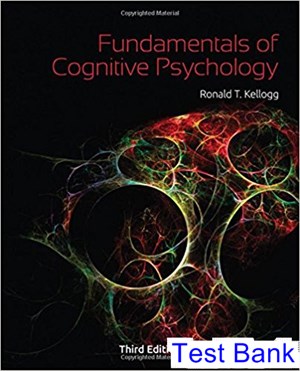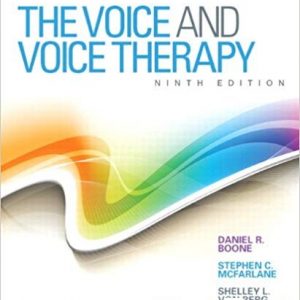This is completed downloadable of Fundamentals of Cognitive Psychology 3rd Edition Kellogg Test Bank

Product Details:
- ISBN-10 : 1483347583
- ISBN-13 : 978-1483347585
- Author: Ronald T. Kellogg
With its reader-friendly style, this concise text offers a solid introduction to the fundamental concepts of cognitive psychology. Covering neuroimaging, emotion, and cognitive development, author Ronald T. Kellogg integrates the latest developments in cognitive neuroscience for a cutting-edge exploration of the field today. With new pedagogy, relevant examples, and an expanded full-color insert, Fundamentals of Cognitive Psychology, Third Edition is sure to engage students interested in an accessible and applied approach to cognitive psychology.
Table of Content:
- 1 Introduction
- Learning Objectives
- Scope of Cognitive Psychology
- Historical Perspective
- Defining Cognitive Psychology
- Core Concepts
- Mental Representations
- Stages of Processing
- Serial Versus Parallel Processing
- Hierarchical Systems
- Consciousness
- Emotion
- The Brain
- Cerebral Cortex
- Parallel Processing
- Research Methods
- Behavioral Measures
- Physiological Measures
- Experimental Manipulations
- Combining Techniques
- Summary
- Key Terms
- Questions for Thought
- 2 Perception
- Learning Objectives
- Visual Consciousness
- Visual Pathways
- Visual Cortex
- Pattern Recognition
- Agnosia
- Top-Down Versus Bottom-Up Processes
- Object Representations
- Modularity
- Holistic Versus Analytic Processing
- Face Perception
- Speech Perception
- Summary
- Key Terms
- Questions for Thought
- 3 Attention
- Learning Objectives
- Filter Theories
- Early Selection
- Attenuation
- Late Selection
- Capacity Theories
- Mental Effort
- Multiple Resources
- Filter Theories and Capacity Theories: Conclusion
- Automatic Processes
- Criteria of Automaticity
- Practice and Automaticity
- The Central Bottleneck
- Visual Attention
- Neural Networks of Attention
- Perceptual Binding
- Subliminal Perception
- Summary
- Key Terms
- Questions for Thought
- 4 Memory Systems
- Learning Objectives
- Sensory Memory
- Iconic Memory
- Echoic Memory
- Short-Term Versus Long-Term Memory
- Serial Position Effects
- Neurological Dissociations
- Capacity
- Duration
- Other Distinguishing Criteria
- Conclusion
- Working Memory
- Multiple-Component Model
- Embedded Process Model
- Conclusion
- Summary
- Key Terms
- Questions for Thought
- 5 Remembering Events
- Learning Objectives
- Types of Long-Term Memory
- Declarative Versus Procedural Memory
- Episodic Versus Semantic Memory
- Criticisms of Multiple Systems
- Mental Time Travel
- The Default Network
- Prospective Memory
- Encoding and Storing Events
- Levels of Processing
- Transfer-Appropriate Processing
- Distinctiveness
- Relational Processing
- Emotion and Memory Storage
- Retrieval Processes
- Retrieval Mode
- Encoding Specificity
- Emotion and Retrieval
- Study Strategies
- Summary
- Key Terms
- Questions for Thought
- 6 Memory Distortions
- Learning Objectives
- Reconstructive Retrieval
- Reconstructing Laboratory Events
- Reconstructing Autobiographical Events
- Encoding Distortions
- Selection
- Interpretation
- Integration
- Source Monitoring
- Memory Illusions
- Confabulation
- Eyewitness Testimony
- Reconstructive Retrieval
- Selective Encoding
- The Misinformation Effect
- Implanted Memories
- Recovered Memories
- Summary
- Key Terms
- Questions for Thought
- 7 Imagery and Knowledge Representation
- Learning Objectives
- Imagery and Abstract Representation
- Visual Imagery
- Propositions
- Conclusion
- Representing Concepts
- Rule-Governed Concepts
- Object Concepts
- Using Semantic Memory
- Semantic Network Models
- The Feature Comparison Model
- Summary
- Key Terms
- Questions for Thought
- 8 Language
- Learning Objectives
- Defining Language
- Origins of Language
- Meaning, Structure, and Use
- Contrasts to Animal Communication
- Representations of Language
- Universal Grammar
- Neural Systems
- Comprehension of Language
- Word Recognition
- Sentence Comprehension
- Discourse Comprehension
- Reading
- Speed and Comprehension
- Dyslexia
- Summary
- Key Terms
- Questions for Thought
- 9 Problem Solving
- Learning Objectives
- Types of Thinking
- Well-Defined and Ill-Defined Problems
- Productive and Reproductive Problem Solving
- Relations Among Terms
- A General Model of Problem Solving
- Representing Problems
- Searching the Problem Space
- Domain-Specific Knowledge and Metacognition
- Creativity
- Historical Versus Process Creativity
- Stages of Creativity
- Creativity Blocks
- Sources of Creativity
- Creative Production
- Fluid Intelligence
- Role of Working Memory
- Einstein’s Brain
- Summary
- Key Terms
- Questions for Thought
- 10 Reasoning and Decision Making
- Learning Objectives
- Syllogistic Reasoning
- Syllogistic Forms
- Common Errors
- Cognitive Constraints
- Conditional Reasoning
- Valid and Invalid Conditional Reasoning
- Common Errors
- Cognitive Constraints
- Decision Making
- Subjective Utility
- Heuristics for Decision Making
- Emotion and Thinking
- The Teenage Brain
- Summary
- Key Terms
- Questions for Thought
- Glossary
- References
- Index
- About the Author





